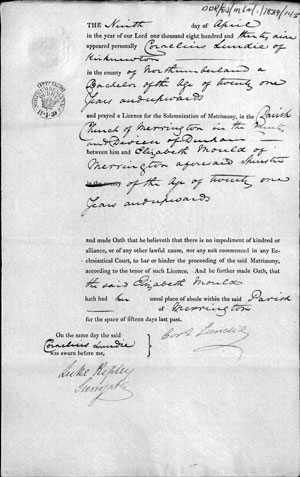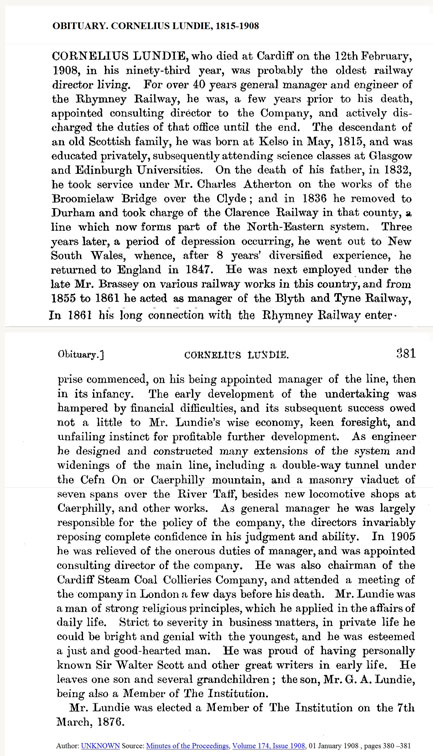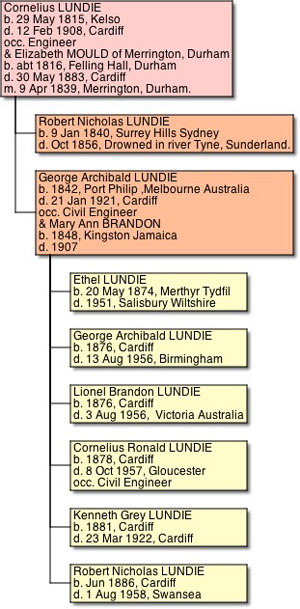

Truth (Brisbane, Qld. : 1900 - 1954), Sunday 12 April 1908, page 7 LIFE OF LUNDIE. WELL KNOWN RAILWAY MANAGER. Example of Grit, Perseverance and Tact. FOR MANY YEARS CONNECTED WITH RAILWAYS IN N.S.W. There are probably thousands of railway men, throughout Australia, who knew Cornelius Lundie, for forty three years general manager of the Rhymney Railway Company in Wales, and there is not a railway director or manager on the British railroads who did not hear with regret of the grand old gentleman's death on February 12 last. Only a fortnight previous, to his death, although 93 years of age, he travelled from Cardiff to London to attend a meeting of directors of a colliery company, of which he was a member. He was unwell at the time, and on his return a severe attack of congestion of the lungs resulted fatally. The following autobiography, was written by Mr. Lundie himself for the "Western Mail", Cardiff and will no doubt be most Interesting to Australian railway men, as an example of what hard GRIT, PERSERVERANCE AND TACT can accomplish. NOTES— FEBRUARY 1905, Cornelius Lundie was born in May 1815 at Kelso in the county of Roxburgh N.B. Where his father and grandfather had been ministers of the parish for nearly a century between them. Having received his early education at home under private tutors, he attended classes in physical and mathematical Science the Universities, of Edinburgh and Glasgow during several winter sessions, working through the summer in the shops of a country millwright at Kelso. After the death of his father, which occurred in 1832, he took service under Mr. Charles Atherton the resident engineer on the works of the Broomielaw Bridge then being erected over the Clyde at Glasgow from the designs of Thomas Telford, who however did not live to see its completion. In the year 1836 Mr. Lundie removed to the Country of Durham, where under the late Thomas Rhodes then engineer for the Exchequer Loan Office, he was entrusted with the completion and early working of the Clarence Railway, which traversed the country between the city of Durham and Stockton-on-Tees and Port Clarence, on the north side of the river, where coal was just BEGINNING TO BE SHIPPED just opposite to what has now become the great ironmaking town of Middlesborough which at that time had no existence. The Clarence Railway has been long absorbed by the North, Eastern Railway Company and now forms a part of the North Eastern main track from north to south. At the time referred to the rails of the permanent way weighed 40lb. per yard, and were laid upon stone blocks measuring 1 foot 4 Inches and 2 feet square except on new embankments, where round larch sleepers measuring 6 inches to 8 Inches in diameter; were used, with the idea that they would be replaced by stone blocks as soon as the newly laid embankments should have settled down. Locomotives engines made by Timothy Hackworth, of Shildon, were used for mineral traffic, the weight of the engines being restricted to nine tons and their speed to six miles an hour, while the passengers were conveyed in carriages of the pattern of the old mail coaches mounted on railway trucks and drawn by horses, which was thought the safer and more suitable method, although, passenger trains had been drawn by locomotive engines then for several years on the Liverpool, and Manchester and the Stockton and Darlington Railways. The work, of construction on the Clarence Railway HAVING BEEN FINISHED and a time of dullness in the engineering world having set in, Mr. Lundie left in the year 1839 for New South Wales; which Colony was just at that time enjoying a large share of public attention. During, the years 1840-1 Mr. Lundle was consulted on various schemes of mining and irrigation, and was employed in surveying for a line of railway between the port of Newcastle, on the Hunter River and the town of Maitland on the same river. The first coal pit in the Colony, had just been sunk at Newcastle. By the year 1841 however, a time of great depression had fallen upon the Colony, in consequence of the price of wool, the staple product, having fallen from 2s. 6d. per lb. to somewhere about 1s. per lb., while at the same time the cheap convict labour had been withdrawn from the settlers, and the first Chinese War had nearly trebled the price of tea, which was the sole beverage in the rural parts and was supplied as part of the wages to all farm servants, as well as food, sugar, soap, and tobacco. In fact, the price of all articles of consumption went up, while the prices of all the products of the country went down, and the result was, that no money could be found for engineering works. CATTLE RAISING IN AUSTRALIA Mr. Lundie, finding himself out of work, applied himself to the staple industries of the country— the rearing of cattle and sheep in the interior, then known as " The Bush," living in tents or bark huts and often sleeping in the open air by "bush fire." The climate is genial, and the life was pleasant enough, the greater part of the day being spent on horseback. In fact, the life from day to day seemed to be one continued picnic. But it is possible to have enough even of that. Gold digging had not begun, nor had the exporting of frozen meat been thought of, and the price of produce did not rise. For instance, a herd of fat bullocks was offered in Sydney market, and the price offered by the butchers was 38s. per head ,The bullocks were eventually boiled down for their tallow, and the net, produce was about 2 pound 10s. per head. Hence, finding, that he was not adding to his substance, Mr. Lundie returned to the old country, in the year 1847. In that year gold was found in the Colony in a form to be worked profitably. A rush was made to the "diggings" from all, parts of the world, population increased, and, a good demand arose for all the produce of the price of everything rose, and a wave of prosperity flowed over the whole region. No doubt, had Mr. Lundie remained he would have shared in the general prosperity. As it was, he came home with his capital very considerably diminished. BACK IN ENGLAND. On reaching England, Mr. Lundie took service under Mr. Brassey, who was then engaged in making railways extending from Preston, in Lancashire, to Edinburgh and Glasgow, besides extensive works in the North of France. To Mr. Lundle was entrusted the making of that part of the Caledonian Railway extending from Moffat, in Dumfriesshire to the "Beatock Summit," where the railway surmounts the ridge of the Lead Hills, whence it descends to the valley of the Clyde. After the completion of the Caledonian Railway, Mr. Lundie spent some years upon an estate in Lincolnshire, where he was charged with the improvement of the farm buildings and the installation of quarries and brickworks, and for the time he acted as agent for the estate. Having finished his engagement in Lincolnshire In the year 1851, and casting about for some useful enterprise Mr. Lundie, turning his attention to the state of things in Ireland after the severe famine, took a tract of land in the west of the Island, upon which he spent about four years of hard work and some capital; but, as the yield. did not come up to his expectations, he accepted in the year 1855 the combined offers of engineer and manager of the little railway then known as the " Blyth and Tyne " (which has long since been absorbed in the North Eastern system) ; leaving it (the Blyth and Tyne) in a fairly prosperous condition. AT THE RHYMNEY. In the year 1861 Mr. Lundie, removed to Glamorgan, where he took charge of affairs of the Rhymney Railway, having its terminus at the Bute Docks at Cardiff, and supplying the means of transit for the coal and iron and other traffic, including passengers, of the Rhymney Valley, with its tributary valleys, as well us of that arising from its through connections with the Great Western, the London and North Western, and other railways to the east, west and north of the country. On the Rhymney Railway Mr. Lundie's responsibilities extended to the charge of the working departments (exclusive, however, of the secretarial, accountant, and audit offices), the working of all which he conducted for over forty-three years, during which time the extent of the railway was doubled, and its revenue increased sixfold. The above concludes the narrative written, by Mr. Lundie. There can be no doubt that the Rhymney owes much to the careful guidance of Mr. Lundie. When he took charge of the line the revenue was small, comparatively, to what it is now and every possible half-penny had to be saved. Cheeseparing was necessarily the order given to every department and the directors at that time were even more keen on economy than Mr. Lundie himself. He was, however, keen enough to WATCH FOR OPENINGS for traffic in the various valleys which branch off the Rhymney line, and was successful in piloting through Parliament various schemes from which the company, are now reaping rich benefits. No railway manager was more respected, and no board paid more attention to the advice, of its manager than did the Rhymney directors to that of Mr. Lundie; who, while keeping down expenditure in the early days, could forsee the harvest of the future. Three or four years ago the onerous duties of manager were taken off the shoulders of Mr. Lundie, and imposed upon Mr. Prosser, who has been trained by him, and who now occupies the responsible position of general manager. Mr. Lundle, however, was appointed consulting director, which position he held up to the time of his death. Mr, Lundle's social side it is difficult to analyse. At a "Bobby Burns" banquet he was as jovial as the youngest guest present, and some of his speeches at these and other gatherings, of the same character were bright and FULL OF CAUSTIC WIT. But in business he was somewhat severe, and those whose methods did not quite fit in with his were rather tartly treated. He had, however, the reputation of having a good heart. Until the last year or so he had a sprightly step, and his faculties were as keen up to the time of his death as ever' they had been. Probably he was the only man alive on Wednesday morning who had shaken hands with Sir. Walter Scott, and it is said, that he possessed several letters written by the Wizard of the North. Some years ago Queen Victoria received a deputation of railway managers, and singled out Mr. Lundie for special notice, he being the patriarch of that particular class of workers in the interests of the nation.


Cornelius "Corie" Lundie Born 1815 Kelso Manse, Scotland
Married Elizabeth Mould 1839 Merrington, Durham
Died 12 Feb 1908 Cardiff, Wales